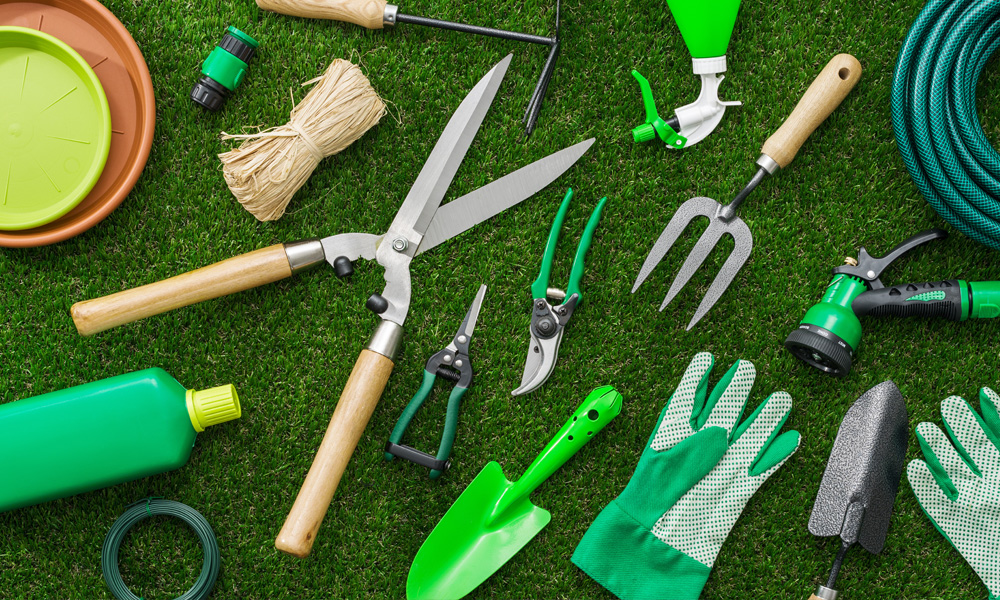Tips for Beginner Gardeners
Tips for Beginner Gardeners

Plant Names
There are 3 main categories which cover most plants:
- Latin Names - Centuries ago, expeditions to discover new lands and natural sciences were funded by the Royal Geographical Society. These were known as "learned societies” and were predominantly made up of students of the classics. This led to a standard being set whereby most plants were given Latin or Greek names; a perfect example - Trachelospermum jasminoides.
- Peoples' Names - Then there are plant names which were named after people, like Gerbera (Dr Traugott Gerber), Gardenia (Alexander Garden), Dahlia (Andreas Dahl).
- Common Names - Thirdly, you will find many of the Latin and Greek names have also common names which lay people understood. For example, the ‘Crinodendron’ in ancient Greek means ‘The Lily Tree’, but outside of the Classic scholars few knew this. What everyday gardeners did know was this tree grew in Chile and had flowers which looked like lanterns. Rather than try to remember ‘Crinodendron’ the general population simply called this plant the ‘Chilean Lantern Tree’. Hereby is the reason plants often have two names – the official Latin/Greek and the easy to remember descriptive ‘common name’.
Types of Plants To Buy
When you buy a plant to grow, you find there are three main ways to buy:
- Young Plants are sold mostly through mail order companies. They are smaller and can often be cheaper. Buying mail order allows for greater variety because a young plant needs little storage space, hence nurseries can have a larger choice. Young plants are often better value, and the postage is less. When you receive a young plant, put into a small pot with compost for 4 weeks to allow the roots to unfurl and then you plant out into your garden.
- Potted plants range from young plants which have been potted on for you and grown in 9cm pots, to fully grown plans in 10+ litre pots. Depending on the size the costs rise quickly, however buying fully grown plants is a quick way to establish your garden.
- Bare Roots are a traditional way to garden. If I have two beautiful roses and you want one, what I would do is wait until my roses go into dormancy, cut some of the top stems away from one, and dig up its root. I send you the root, which you then replant. Then when the rose awakens, it starts to regrow - but now in YOUR garden. You can find bare roots for most plants and are a good way to garden, because you know you are buying a plant which had flourished the previous year.
Soil
- Most soil in British gardens are slightly acidic and luckily most plants prefer slightly acidic soil. There are plants which prefer more acidity and for these plants you can buy ERICACEOUS compost, you will see bags of this alongside ‘general purpose’ compost at your local garden centre. Ericaceous compost increases the acidity of your soil.
- There are plants which like alkaline soil such as lavender, geraniums, dianthus, and campanula. To increase your soils alkalinity, you simply add a handful of agricultural lime.
- However, unless your plant has specific needs you will find nearly everything grows in the slight acidity you most likely have – though it is good to know your soil type. Best do some research about your plant just in case you need to add some ericaceous compost or lime.
- Sandy soil is fast draining though may be not so fertile.
- Clay soil is slow draining and needs to be broken up and mixed with friable organic material.
- If you have a LOAM soil, this is good because it is fertile.
Did you know blue hydrangeas like acid soil and pink hydrangeas like alkaline soil? By dramatically changing the pH value of your soil where your hydrangea is planted, you can turn the blue hydrangea pink and the pink hydrangea blue.
Different Lifespans
- Perennials are plants which can live for several years. They slowly develop and offer years of colour and/or perfume.
- Annuals live for one year. Annuals are flamboyant, colourful, and quick.
- Biennials grow for the first year then flower and set seed in the second year.
The Difference Between a Tree and a Shrub
This is something I am frequently asked. I was taught and have always followed this old formula (though I am sure there are other definitions).
- A tree is a woody plant having one erect perennial stem (trunk) at least 3 inches in diameter at a point 4 1/2 feet above the ground, a formed crown of foliage, and a mature height of at least 13 feet.
- If this formula is not followed, then it is a shrub.
- The name shrub and bush are interchangeable.
Watering
- Check your plants' watering requirements because this will vary with each species. Annuals need regular watering. Perennials less so and roses need a lot.
- Bedding plants need regular watering in the summer and plants which produce a perfume need water to create a vapour which helps broadcast the scent molecules.
- Few outdoor plants need watering in winter for three reasons:
- The rain is enough.
- No plant likes sitting with its roots in icy water.
- The plants are usually dormant.
Hardiness
Plants originate from various parts of the world, and many cannot survive in lower temperatures. Therefore, you must find out the ‘hardiness’ of your plant. Naturally, you wish to select perennials which will survive our winters. Annuals can survive May-October no matter. The Royal Horticultural Society have classifications. If your plant isn’t hardy enough, you must either move it to a frost-free environment, or mulch by putting a protective layer of woodchips/straw/pine needles around the base of the plant. The RHS classifications are as follows:
H1a: Warmer than 15°C
H1b: 10°C to 15°C
H1c: 5°C to 10°C
H2: 1°C to 5°C
H3: -5°C to 1°C
H4: -10°C to -5°C
H5: -15°C to -10°C
H6: -20°C to -15°C
H7: Colder than -20°C
Maintenance- Often & Small Is The Key
Once you have your garden planted and growing, small and regular effort is the key to successful gardening. Every few days stroll around the garden and at your leisure perform these tasks. (This keeps gardening a pleasure because it is better to perform many easy tasks than break your back and your spirit, by performing occasional large tasks).
- Most soils are bereft of all 12 minerals plants need, so feeding is a way to ensure your plants receive all the nourishment necessary. Annuals require regular feeding, perennials occasional feeding. You can either buy slow-release fertilisers, which are in the form of beads you dig into the soil around the plant, or you can buy soluble fertilisers which you dilute in a watering can. New gardeners frequently blame themselves if their plants do not grow, yet countless times it is the case the plants do not have enough nutrition.
- Look at your flowers and any which look like they are past their best remove from the plant. This encourages more flowers.
- Always pull out a few weeds as you walk around. Weeding is one of the most onerous tasks in gardening. It is better to remove 5 weeds each day over 100 days than try and remove 500 weeds in one day.
- Look for slug damage and consider ways to be rid of them. There are several options for removing slugs. Choose which method suits you moral compass. I buy slug killer.
- Pests and fungal infections. Check your plants for pests and fungal infection. In this country both can happen. There are a multitude of approved safe pesticides and fungicides available in all garden centres. A couple of sprays usually does the trick.
- Come autumn/early spring, you need to start pruning some of your perennials. Again, you must ask the ‘Google God’ the most beneficial way to cutback each plant because some like a hard prune and some like a gentle prune.
- Look after the soil and the soil will look after your plants.
Let's Put Everything Into Action With Trachelospermum Jasminoides
Trachelopermum is Latin. ‘Trachel’ means neck (just like ‘trachea’ in our necks) and ‘spermum ‘means seed. When early naturalist discovered this plant, they found its seed looked like a neck. Next, they found out the flowers had a jasmine-like scent, which in Latin is ‘jasminoides’. Hence, keeping in mind the classic scholars standards, this plant had to be named the Trachelospermum jasminoides – seed like a neck and smelled like jasmine.
The everyday populace noticed each flower in the Trachelospermum jasminoides was star shaped and agreed it had a jasmine scent, so the ‘common name became ‘Star Jasmine’. Simple.
I bought a grown ‘Star Jasmine’ in a 2-litre pot and as it was springtime decided to plant straight out. This is a climbing perennial plant from forests in Asia, so I will grow against a wall and let it develop over several years. Forest soil is slightly acidic, as is my garden, and in Asia it is generally warm and wet. Therefore, I will grow in a sunny aspect and ensure the plant receives regular watering which will also help the perfume. Forest floors are also fast draining; consequently, I help the drainage by mixing in some sand around the planting hole. Before planting I will throw in a few slow-release fertiliser beads. Checking the hardiness of my plant, I discover my ‘Star Jasmine’ may not survive a really cold winter, so I put some wood chips around the base of the plant which will protect the roots from frost and also hold the moisture during the summer. Google informs me ‘Star Jasmine’ can grow 8 metres high and when it reaches the height I want, which is 2 metres, to cut back in early spring when above my required height.
How easy is this? You can do this, I can do this, we can all do this.
Clearly gardening is not difficult and contributes so much to your mental and physical well-being.
Here are two quotes to sum up:
“There are no gardening mistakes, only experiments” – Joyce Kilburn Phillips .
“Stop reading blogs and just crack on”- Me
Until next time
David





